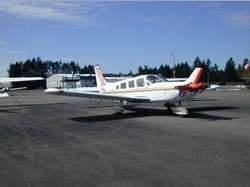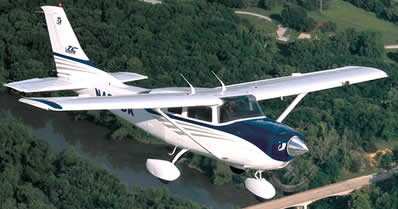Hot & High A Common Factor In NM, NV Fatals
 With the hotter
temperatures of summer comes a potential, hidden danger for
aircraft operations... density altitude, in which air becomes less
dense as temperatures climb. And though its too early to determine
for certain, the combination of heavy loads and high D.A. may have
played a role in a pair of weekend crashes that claimed nine lives
between them.
With the hotter
temperatures of summer comes a potential, hidden danger for
aircraft operations... density altitude, in which air becomes less
dense as temperatures climb. And though its too early to determine
for certain, the combination of heavy loads and high D.A. may have
played a role in a pair of weekend crashes that claimed nine lives
between them.
As ANN reported, a Piper PA-32-300 Cherokee
Six (type shown at right) with four people onboard impacted the
eastern side of Mount Charleston, 20 miles northwest of North Las
Vegas, NV in the vicinity of the Echo Canyon recreation area.
The aircraft was on an IFR flight plan for Byron, CA, according
to information on FlightAware.com.
The FAA and NTSB have just begun their investigations into the
crash, and it's too early to determine what factors played a part
in the accident... but it's difficult to ignore the fact Mount
Charleston tops out at just under 12,000 feet, and it was a
seasonably hot day in southwestern Nevada.
An ANN News-Spy in the region sent along the following
information Monday. "At 2:45 PM the temperature @ VGT was at least
105 degrees F (105.8 F, according to the temperature reading at
VGT as cited by the FAA -- Ed.) The crash
took place around 7,000 MSL, the temperature at that altitude had
to be near 90 degrees F. The density altitude would be just over
10,000 ft."
Though noted as a strong performer and capable of hauling a
relatively heavy load, a Cherokee Six might have difficulties
climbing in such conditions with four persons onboard, the person
added.
IDENTIFICATION
Regis#: 4063W
Make/Model: PA32 Description: PA-32
Cherokee Six, Six, Saratoga, Turbo
Date: 06/29/2008 Time: 2150
Event Type: Accident Highest Injury:
Fatal Mid Air: N Missing:
N
Damage: Destroyed
LOCATION
City: NORTH LAS VEGAS State: NV
Country: US
DESCRIPTION
AIRCRAFT CRASHED AT THE 7000 FT LEVEL OF MOUNT
CHARLESTON, THE FOUR
PERSONS ON BOARD WERE FATALLY INJURED, 22 MILES FROM NORTH
LAS VEGAS, NV
INJURY DATA Total
Fatal: 4
# Crew: 1 Fat:
1 Ser:
0 Min:
0 Unk:
# Pass: 3 Fat:
3 Ser:
0 Min:
0 Unk:
# Grnd:
Fat: 0 Ser:
0 Min:
0 Unk:
WEATHER: METAR KVGT 282205Z 14011G17 10SM CLR 41/02
OTHER DATA
Activity: Pleasure Phase:
Unknown Operation: OTHER
FAA FSDO: LAS VEGAS, NV
(WP19)
Entry date: 06/30/2008
Similar circumstances may also have come into play Sunday
afternoon in Santa Rosa, NM, about 100 miles east of Albuquerque.
According to local news reports, a normally-aspirated Cessna U206F
with five persons onboard crashed immediately after takeoff from
Route 66 Airport (I58).

The aircraft was transporting a family from Gilbert, AZ. Santa
Rosa police Sgt. Lorenzo Mata told The Albuquerque Journal the
aircraft stopped in Santa Rosa for fuel, before taking off bound
for Chicago. Witnesses said the plane made a sharp bank to the left
prior to impact.
The aircraft came to rest 400 feet off the end of the runway,
and was on fire when Mata arrived on scene. The fire soon spread to
one of the Stationair's wing tanks. "When the explosion came, it
blew me back a little," he said. "It's lucky there wasn't a bigger
explosion, or I would have been a casualty."
I58 lies at 4,792 feet MSL. A nearby recording station noted a
temperature of 19 degrees Celsius, or only 66 degrees F. Those are
relatively cool conditions... though at this point it's unknown how
heavily loaded the plane was at the time of the accident, and how
that may have reduced the Cessna's takeoff performance.
Again, at this point, any speculation on anyone's part is just
that -- speculation. Furthermore, no one wants to "armchair
quarterback" a fatal aircraft accident.
Consider this, though: as temperatures rise throughout the US,
it behooves all of us to take a close look at the performance
charts for our aircraft, to remind ourselves what the manufacturer
says we can expect when trying to operate far outside of "standard"
conditions.
You may be surprised... even shocked... at how much performance
is reduced. But checking before we fly is another step we all can
take, to prevent articles like this one from being written about
us.
 IDENTIFICATION
IDENTIFICATION
Regis#: 2905Q
Make/Model: C206 Description: 206,
P206, T206, TP206, U206, TU206, (T
Date: 06/29/2008 Time: 1900
Event Type: Accident Highest Injury:
Fatal Mid Air: N Missing:
N
Damage: Destroyed
LOCATION
City: SANTA ROSA State: NM Country:
US
DESCRIPTION
AIRCRAFT, SHORTLY AFTER TAKEOFF, CRASHED, THE FIVE PERSONS
ON BOARD WERE
FATALLY INJURED, SANTA ROSA, NM
INJURY DATA Total
Fatal: 5
# Crew: 1 Fat:
1 Ser:
0 Min:
0 Unk:
# Pass: 4 Fat:
4 Ser:
0 Min:
0 Unk:
# Grnd:
Fat: 0 Ser:
0 Min:
0 Unk:
WEATHER: KLUS 2918532 AUTO 14013G17KT 10SM SCT032 BKN038 BKN048
19/12 A3048
OTHER DATA
Activity: Unknown Phase:
Take-off Operation: OTHER
FAA FSDO: ALBUQUERQUE, NM
(SW01)
Entry date: 06/30/2008
 Aero-News: Quote of the Day (04.28.25)
Aero-News: Quote of the Day (04.28.25) ANN's Daily Aero-Term (04.28.25): Decision Altitude (DA)
ANN's Daily Aero-Term (04.28.25): Decision Altitude (DA) ANN's Daily Aero-Linx (04.28.25)
ANN's Daily Aero-Linx (04.28.25) Airborne-Flight Training 04.24.25: GA Refocused, Seminole/Epic, WestJet v TFWP
Airborne-Flight Training 04.24.25: GA Refocused, Seminole/Epic, WestJet v TFWP Aero-News: Quote of the Day (04.29.25)
Aero-News: Quote of the Day (04.29.25)





